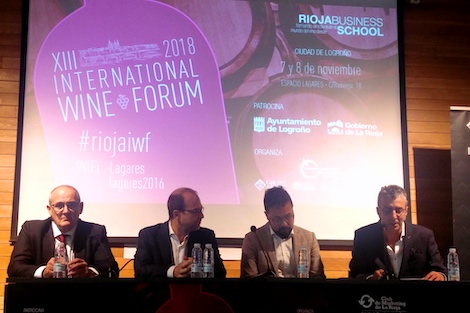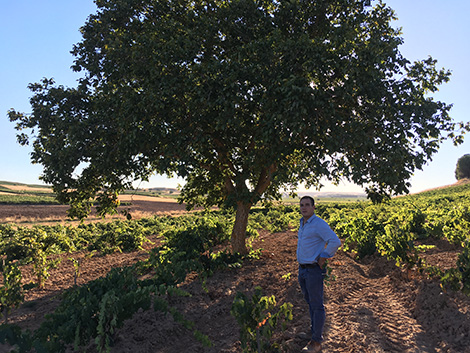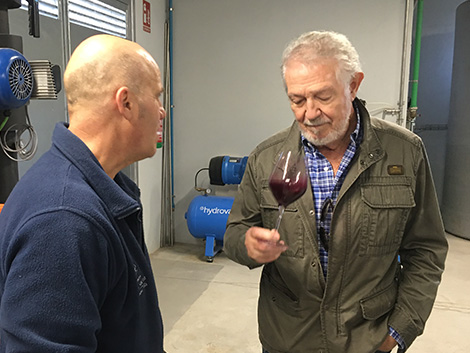The challenges ahead: “Rural areas, medium-range wines and the cultural sphere”

Last week, Spanish Masters of Wine Pedro Ballesteros, Andreas Kubach and Fernando Mora travelled to Logroño to take part in a roundtable at the city’s 13th International Wine Forum.
Their presence always makes the headlines, but what was extremely refreshing their candid and unequivocal remarks about the country’s wine sector.
Without mincing their words and helped by their global vision of wine, the three experts talked about the need to appreciate Spain’s rural areas, work harder and better on medium-range wines and move on from the technical, organoleptic perspective of wine to value its cultural dimension and convey this message to consumers. “Wine culture has never existed in Spain”, concluded Kubach.
Mora, Kubach and Ballesteros launched similar messages on the eve of their roundtable, during a tasting of singular wines and dinner organized by La Rioja Marketing Club at restaurant Tondeluna owned by chef Francis Paniego. As diners tasted Ad Libitum Maturana Blanca by Juan Carlos Sancha and Ojuel Supurao, which recover Rioja’s sweet winemaking tradition, Ballesteros praised the diversity that these wines represent but openly criticized the decision by Rioja Regulatory Board to allow non-local varieties and categories that devalue the Rioja brand.
“What is Rioja? I get more and more confused every day. These wines that you’re drinking tonight or a Gran Reserva 890 are both Rioja but you could be drinking a simple little Verdejo or Cava as you’d also be drinking Rioja. 99% of the people who drink and pay for Rioja want it as a type of wine not as a little map,”, argued Ballesteros in front of an audience of wine producers and the conspicuous absence of the Regulatory Board, whose members were on an official trip to Burgundy. “This land has an enormous capacity to produce very high quality, Champenoise-method sparkling wines, but they should not be called Rioja. Coca-Cola doesn’t use its brand for Fanta. Both are made by the same company but they are not stupid and use two different brands.”
“Unworthy wines”
On the next day, Ballesteros insisted again on the value of the territory and tied this with other structural problems that, in his view, are hurting the country. “In Spain, rural communities have never been organized; we lack the tradition of defending and championing our countryside that you see in France. Rioja flies the flag for Spain in terms of wine but it allows unworthy wines with no respect for local tradition and culture to carry its name. That is totally out of the question in France or Italy. This approach means that we are not laying any foundations. If we produce cheap grapes, we will never have good-quality wines sold at fair prices. Do you know the price of the so-reviled Prosecco grapes with yields of 16,000-20,000 kg? They are sold at €1/kg.”
When Alberto Gil, journalist at local newspaper Diario La Rioja and debate moderator, asked whether Spanish wines are fashionable, Fernando Mora said that there are new projects launched by “people with plural ideas who are making origin-based wines” but, in tune with his fellow MWs, rejected the idea of fashion. “It’s people like us who drink 50% of the country’s premium wines; we live in a bubble.”
For Kubach, the market is aware that there are great quality wines being made across Spain, but only at the top level. “We are good in terms of entry-level wines because we’re ultra-competitive albeit unsustainable. We are doing badly on the medium level, with wines lacking in personality, emotion and cultural ties; these wines don’t even express the place they come from.”
For the Germany-born Master of Wine, in Spain wine has always been perceived as an agricultural commodity, without the cultural dimension that makes people travel through a bottle of wine. “Italians are much more skilled than us in this regard. A medium-priced wine is perfectly distinguishable between different Italian regions; they have preserved their grapes, traditions and styles. Here, all Tempranillos follow the same one-size-fits-all strategy: the same grape, the same clone and the same yeast. We have to overcome the purely technical stage and connect with the cultural realm to have wines that represent the territory and its traditions. This is already happening on the top level, where we have exciting wines with personality, but we must apply this to the medium range,” added Kubach.
With regard to top-quality wines, Ballesteros pointed out that Spain is still “insignificant” compared to France, Italy or California. “Their brands have volume and command high prices. We still don’t have that. Vega Sicilia is the only one with true international prestige.” Ballesteros added: “The country’s critics hate large companies and cooperatives because they are big. We go berserk over a young, hippy-like grower who tends a couple of hectares. I also like those wines, but what we need in Spain is people who are able to create prestigious brands across the world that produce large quantities of quality wines. A producer who manages to sell 1m bottles at €30 each would be the best for Spain, but Spaniards themselves reject that idea.”
Singular vineyards and old vines
The new quality categories and the work of the appellations centred part of the debate. Mora, whose MW research paper was about classifications, said: “Origin, which is the only thing that cannot be relocated, can be classified in many ways but starting the house on the roof is not a good idea. The DO Cava has created the Cava de Paraje category but doesn’t allow producers to say on the label whether the wine comes from Penedès or Almendralejo [Extremadura] and this is a problem.” Mora, who said that starting to classify from the top “is a matter of economic interests and lacks transparency”, also questioned the fact that the new singular vineyard classification in Rioja keeps wines made from two exceptional vineyards out of the top of the pyramid. “The fact is that DOs fail to provide value to grape growers,” Mora pointed out.
Kubach told his experience in Rioja Alavesa, where his group Península Vinicultores has made its first wines in Villabuena, Leza and Samaniego. “Each one of them has its own personality but the new rules are useless for us. Two of our wines cannot be labelled as village wines because the winery is in Villabuena. What’s the point of coming to Rioja if we cannot sell it as Rioja?” wondered Kubach. “It seems as if the rules were approved to make them fail.”
Ballesteros praised the work done in Bierzo (“it is the only DO that is trying to improve the grapes issue; the others create monopolies that area associated with the wineries”) and said that although he supports “anything that involves adding value to a territory”, Spain’s differentiating factor resides on the soils, the age of the vines and their training systems. “Championing old vines in certain areas as an element of terroir seems to me at times far more important than single vineyards which, in their maximum silliness are called vino de pago,” he added.
When Mora called for the regulation of old vines with “a minimum of ethics”, Ballesteros encouraged producers to privately create “a serious, demanding, real and credible definition supported by certification systems. If we are waiting for the DOs to do this, we will end up with a rule that we dislike because the DOs will reach a one-size-fits-all compromise, which incidentally is their duty.”
The debate, which forced everyone in the trade to do some self-introspection, ended on an upbeat tone as the Masters of Wine praised the “creative, free and global spirit” of the new generations. At the end of the day, said Ballesteros, “wine helps us to dream.”

Yolanda Ortiz de Arri
A journalist with over 25 years' experience in national and international media. WSET3, wine educator and translator
NEWSLETTER
Join our community of Spanish wine lovers






